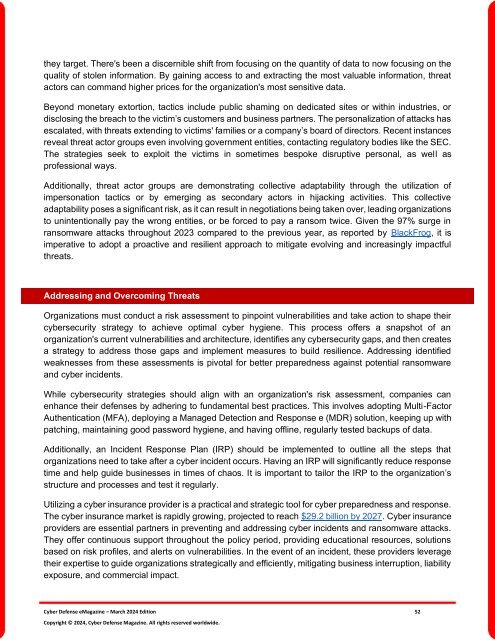The Cyber Defense eMagazine March Edition for 2024
Cyber Defense eMagazine March Edition for 2024 #CDM #CYBERDEFENSEMAG @CyberDefenseMag by @Miliefsky a world-renowned cyber security expert and the Publisher of Cyber Defense Magazine as part of the Cyber Defense Media Group as well as Yan Ross, Editor-in-Chief and many more writers, partners and supporters who make this an awesome publication! 225 page March Edition fully packed with some of our best content. Thank you all and to our readers! OSINT ROCKS! #CDM #CDMG #OSINT #CYBERSECURITY #INFOSEC #BEST #PRACTICES #TIPS #TECHNIQUES
Cyber Defense eMagazine March Edition for 2024 #CDM #CYBERDEFENSEMAG @CyberDefenseMag by @Miliefsky a world-renowned cyber security expert and the Publisher of Cyber Defense Magazine as part of the Cyber Defense Media Group as well as Yan Ross, Editor-in-Chief and many more writers, partners and supporters who make this an awesome publication! 225 page March Edition fully packed with some of our best content. Thank you all and to our readers! OSINT ROCKS! #CDM #CDMG #OSINT #CYBERSECURITY #INFOSEC #BEST #PRACTICES #TIPS #TECHNIQUES
You also want an ePaper? Increase the reach of your titles
YUMPU automatically turns print PDFs into web optimized ePapers that Google loves.
they target. <strong>The</strong>re's been a discernible shift from focusing on the quantity of data to now focusing on the<br />
quality of stolen in<strong>for</strong>mation. By gaining access to and extracting the most valuable in<strong>for</strong>mation, threat<br />
actors can command higher prices <strong>for</strong> the organization's most sensitive data.<br />
Beyond monetary extortion, tactics include public shaming on dedicated sites or within industries, or<br />
disclosing the breach to the victim’s customers and business partners. <strong>The</strong> personalization of attacks has<br />
escalated, with threats extending to victims' families or a company’s board of directors. Recent instances<br />
reveal threat actor groups even involving government entities, contacting regulatory bodies like the SEC.<br />
<strong>The</strong> strategies seek to exploit the victims in sometimes bespoke disruptive personal, as well as<br />
professional ways.<br />
Additionally, threat actor groups are demonstrating collective adaptability through the utilization of<br />
impersonation tactics or by emerging as secondary actors in hijacking activities. This collective<br />
adaptability poses a significant risk, as it can result in negotiations being taken over, leading organizations<br />
to unintentionally pay the wrong entities, or be <strong>for</strong>ced to pay a ransom twice. Given the 97% surge in<br />
ransomware attacks throughout 2023 compared to the previous year, as reported by BlackFrog, it is<br />
imperative to adopt a proactive and resilient approach to mitigate evolving and increasingly impactful<br />
threats.<br />
Addressing and Overcoming Threats<br />
Organizations must conduct a risk assessment to pinpoint vulnerabilities and take action to shape their<br />
cybersecurity strategy to achieve optimal cyber hygiene. This process offers a snapshot of an<br />
organization's current vulnerabilities and architecture, identifies any cybersecurity gaps, and then creates<br />
a strategy to address those gaps and implement measures to build resilience. Addressing identified<br />
weaknesses from these assessments is pivotal <strong>for</strong> better preparedness against potential ransomware<br />
and cyber incidents.<br />
While cybersecurity strategies should align with an organization's risk assessment, companies can<br />
enhance their defenses by adhering to fundamental best practices. This involves adopting Multi-Factor<br />
Authentication (MFA), deploying a Managed Detection and Response e (MDR) solution, keeping up with<br />
patching, maintaining good password hygiene, and having offline, regularly tested backups of data.<br />
Additionally, an Incident Response Plan (IRP) should be implemented to outline all the steps that<br />
organizations need to take after a cyber incident occurs. Having an IRP will significantly reduce response<br />
time and help guide businesses in times of chaos. It is important to tailor the IRP to the organization’s<br />
structure and processes and test it regularly.<br />
Utilizing a cyber insurance provider is a practical and strategic tool <strong>for</strong> cyber preparedness and response.<br />
<strong>The</strong> cyber insurance market is rapidly growing, projected to reach $29.2 billion by 2027. <strong>Cyber</strong> insurance<br />
providers are essential partners in preventing and addressing cyber incidents and ransomware attacks.<br />
<strong>The</strong>y offer continuous support throughout the policy period, providing educational resources, solutions<br />
based on risk profiles, and alerts on vulnerabilities. In the event of an incident, these providers leverage<br />
their expertise to guide organizations strategically and efficiently, mitigating business interruption, liability<br />
exposure, and commercial impact.<br />
<strong>Cyber</strong> <strong>Defense</strong> <strong>eMagazine</strong> – <strong>March</strong> <strong>2024</strong> <strong>Edition</strong> 52<br />
Copyright © <strong>2024</strong>, <strong>Cyber</strong> <strong>Defense</strong> Magazine. All rights reserved worldwide.

















